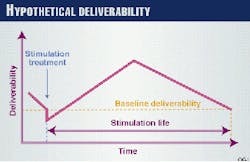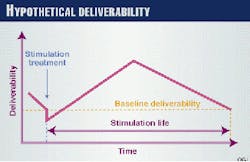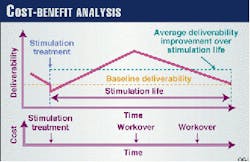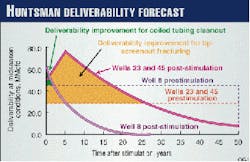A new approach can better address the issues related to evaluating the economic benefits of different methods for stimulating gas storage wells.
This fourth and concluding part of a four-part series (Part 1, OGJ, Nov. 15, 1999, p. 43; Part 2, Nov. 29, 1999, p. 58; and Part 3, Dec. 6, 1999, p. 68) discusses economic evaluation approaches typically used by industry and the new approach that overcomes several shortcomings of today's practices.
Also, the economic attractiveness of four techniques-tip-screenout (TSO), liquid CO2 with proppant, extreme overbalance (EOB), and high energy gas fracturing (HEGF)-is compared to more traditional methods such as well cleanouts, reperforating, and acidizing. The comparison is based on actual field results.
Evaluation approaches
The most common approach for evaluating deliverability-enhancement economics is to measure the immediate improvement in deliverability from a treatment and then divide it by treatment cost to obtain a cost metric in $/Mcfd.
Obviously, operators seek to perform deliverability enhancement activities that minimize the value of this metric. While at first pass this approach seems reasonable, it has several important limitations.
This metric fundamentally is a measure of deliverability maintenance cost and not of value creation. This approach is based upon the premise that a certain deliverability level for a well or field must be maintained for facility certification in a given market, both from the standpoint of geographic location and storage service type.
The challenge is to minimize the cost of maintaining the deliverability level and to assume a deliverability decline rate if the maintenance cost is not spent. This simple approach, however, does not accurately reflect what actually occurs in practice.
Three issues are particularly noteworthy:
1. The deliverability response of a well to a stimulation treatment is not static over time. Rather, deliverability is highly variable, and the magnitude and extent of that variability are at least in part a function of the treatment.
Fig. 1 illustrates a gas storage well's hypothetical deliverability response to a stimulation treatment. At first, deliverability immediately following a treatment may be reduced, possibly because of near-wellbore fluid resaturation effects. Over time, that damage cleans up, and the deliverability benefit of the stimulation treatment is realized.
Later, however, deliverability begins to decline as damage mechanisms that originally led to decreased deliverability appear and the well eventually returns to its prestimulation condition. Damage may be due to fines mobilization, scale deposition, the introduction of foreign particulate matter, etc.
Clearly, not just the immediate stimulation impact but the overall life-cycle deliverability, including magnitude of maximum deliverability enhancement as well as the duration over which enhancement is achieved, must be the overriding considerations for an economic evaluation.
2. The cost of both the treatment and subsequent costs over the life cycle must be considered.
For example, a hydraulic fracture treatment may provide a considerable and long-lasting deliverability improvement but may also require subsequent workovers to remove accumulated proppant that can flow-back over the normal course of gas withdrawal operations.
These subsequent costs must also be considered when the costs of various deliverability enhancement approaches are compared.
3. Particularly important when comparing deliverability responses of different treatments in different wells with different prestimulation conditions is the need to normalize the data to a common baseline.
For example, a 10 MMcfd improvement in deliverability for a well with high permeability and high prestimulation skin condition may not be as valuable as obtaining a 10-MMcfd deliverability improvement in a low-permeability well with low prestimulation skin.
Normalizing these comparisons to a common prestimulation deliverability level is critical for evaluating the relative effectiveness of various well enhancement methods. Only then can one select the most effective deliverability enhancement strategies.
New approach
A new approach has been developed that addresses the previously mentioned issues and hence is better at evaluating the relative economic performance of different stimulation methods.
Although it still incorporates certain simplifying assumptions, it represents an important improvement over cost-benefit analysis that includes only instantaneous deliverability and cost information.
The first step in the new approach is to estimate for each treatment or well an average deliverability improvement over the stimulated production life (Fig. 2).
Both the average deliverability and the stimulated production life require some knowledge of the deliverability profile over time. Because this information is frequently not known in a timely manner, if ever, some probability analysis is required to deal with this uncertainty. This information, however, was collected as part of the test fracturing project.
The second step is to account for the total costs associated with a stimulation treatment. This includes subsequent workovers that might be required, as well as different stimulated production lives.
All life-cycle costs are estimated at a discounted net present value and then divided by the stimulated production life to obtain an average annual expenditure, in present-value dollars.
To compute the cost-benefit ratio, the average deliverability enhancement is divided into this value. The resulting metric is $/Mcfd/year. This metric can be used to compare the annual cost of deliverability maintenance between different deliverability-enhancement approaches.
Example
To illustrate the new approach, the following example shows the cost-benefit analysis of tip-screenout fracturing vs. wellbore cleanouts for the Huntsman field, Cheyenne County, Neb., operated by KN Interstate Gas Transmission Co., Denver.
In this case, tip-screenout fracturing was being evaluated as a means to improve deliverability in this high-permeability reservoir. To compare its costs and benefits, a wellbore was cleaned out with coiled tubing, a deliverability enhancement approach frequently used in the field.
Table 1 summarizes the information needed for the analysis. The only information with actual data is pre and post-stimulation deliverability and treatment costs.
The remaining (unknown) input data were estimated. The average deliverability decline rate for the field is about 9%/year. Presumably, this is caused by a formation damage mechanism.
For the cleanout treatment, a 50% greater decline rate was assumed because wellbore fill would tend to accelerate decline. In the case of the fracturing treatment, a 50% lower decline rate was assumed because less, near-well pressure drop due to induced hydraulic fracture would likely mitigate most formation damage mechanisms, such as fines mobilization and scale deposition.
The time to reach peak rate would be zero for the cleanout treatment, but a value of 5 years was assumed for the fracture treatment. This is consistent with deliverability histories observed in other gas storage fields.
The maximum peak rate for the fracture treatment was assumed to be 50% greater than the immediate post-stimulation response. Again, improvements in deliverability response from fracture treatments of several orders of magnitude have been observed in some cases, and hence a 50% value is realistic and may be conservative.
The peak rate for the cleanout treatment would be the immediate post-treatment response. Fig. 3 illustrates the deliverability profiles for each well.
Finally, no subsequent workovers would be expected for the cleanout treatment, but one wellbore cleanout workover to remove accumulated proppant every fifth year for the fractured well was assumed, at a cost of $13,600/cleanout.
Given the uncertainty surrounding many of the input variables, statistical methods such as Monte Carlo simulation can be used in the cost-benefit analysis, at least until more and better information on deliverability profiles following stimulation treatments is collected.
A standard deviation for each of the assumed parameters of 25% of the mean value was used in the Monte Carlo simulation of this example problem.
Fig. 4 shows the results of the example problem. The average cost of deliverability maintenance is $0.08/Mcfd/year for the tip-screenout treatment and $0.77/Mcfd/year for the cleanout treatment.
But if only immediate deliverability response and costs were considered, one would conclude that the cleanout treatments were more cost effective, providing added deliverability at a cost of $0.81/Mcfd as compared to $1.28/Mcfd for the tip-screenout treatments.
This example clearly shows why life-cycle deliverabilities and costs must be considered when comparing deliverability-enhancement strategies.
Field tests
Table 2 provides the results of applying the new analysis approach to the field tests of each new and novel fracture stimulation technologies previously discussed. Several conclusions can be drawn from this information.
Tip-screenout fracturing is clearly an attractive deliverability enhancement option, providing economically superior results at each site where it was tested. Comparisons of the technique were made to wellbore cleanouts, reperforating, acidizing, and even advanced high-proppant concentration hydraulic fracturing.
Liquid CO2 with proppant fracturing, while not providing economically superior results over conventional and advanced hydraulic fracturing, has potential in certain reservoir settings.
Unique characteristics at each of the CO2 test sites were unfavorable for its application. These characteristics included high permeability, high fracture gradient, and the presence of pre-existing hydraulic fractures.
With careful consideration of site conditions, liquid CO2 with proppant fracturing may yield economically superior deliverability-enhancement results over other methods.
The operational complexities and previously lacking design tools for EOB fracturing make it difficult to justify the technique for widespread application in gas storage wells. HEGF fracturing can overcome these obstacles, but as was the case at the Six Lakes field, the technique was inappropriate because of the damage from salt deposition.
These techniques may be best suited for original completions to overcome nonrecurring drilling or completion damage.
The information required to perform the economic analyses presented is not widely available in the storage industry today. To use the new approach and improve the economic performance of gas storage assets, storage field operators must begin collecting more detailed deliverability information on a more regular basis.
The improvement in economic performance realized by using this approach could more than offset any additional costs for data collection.
Acknowledgments
The work discussed in this four-part series was funded by the US Department of Energy under the project, "New and Novel Fracture Stimulation Technologies for the Revitalization of Existing Gas Storage Wells" (Contract No. DE-AC21-94MC31112) and later by the Gas Research Institute (Contract No. 5097-270-4057).
The authors wish to thank the many organizations participating and contributing to the project, including Columbia Gas Transmission Corp., Consumers Energy Co., CNG Transmission Corp., KN Interstate Gas Transmission Co., Michigan Consolidated Gas Co., National Fuel Gas Co., Natural Gas Pipeline Co. of America, NSI Technologies Inc., and JFS Research & Consulting Inc. Special thanks also to Jim Ammer, the DOE project manager, for his valuable support and assistance.
References
1. "New and Novel Fracture Stimulation Technologies for the Revitalization of Existing Gas Storage Wells," Status Report, Contract No. DE-AC21-94MC31112, US DOE, June 1998.
2. Reeves, S., et al., "Deliverability Enhancement Through Advanced Fracturing Technologies in Gas Storage Wells," Paper No. SPE56728, SPE Annual Technical Conference and Exhibition, Houston, Oct. 3-6, 1999.
3. Reeves, S., and Beckman, K., "Evaluating the Economics of Gas Storage Well Deliverability Enhancement," Paper No. SPE52962, SPE Hydrocarbon Economics and Evaluation Symposium, Dallas, Mar. 20-23, 1999.






